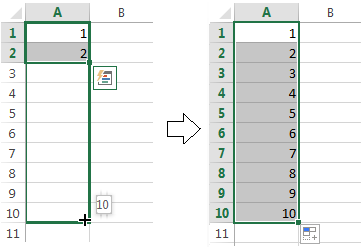Enter A Series Of Numbers, Dates, Or Other Items
Quickly enter a series of numbers or text-and-number combinations Excel can continue a series of numbers, text-and-number combinations, or formulas based on a pattern that you establish. For example, you can enter Item1 in a cell, and then fill the cells below. Enter the first number, date, or list item in the series. Move to the adjacent cell and enter the second number, date, or list item in the series. If you want to enter the.
- Enter A Series Of Numbers Dates Or Other Items Is Known As
- Enter A Series Of Numbers Dates Or Other Items
This is difficult with worksheet functions because dates in excel are simply formatted numbers - only CELL function lets you investigate the format of a cell (and you can't apply that to a range, so a helper column would be required).or, if you only have dates and blanks.or dates and text then it would be sufficient to use COUNT function, i.e. =COUNT(range) That counts numbers so it won't be adequate if you want to distinguish dates from numbers. If you do then the number range could be utilised, e.g. If you have numbers in a range and dates but the numbers will all be lower than 10,000 and the dates will all be relatively recent then you could use this version to exclude the numbers =COUNTIF(range,'10000'). To count numbers or dates that meet a single test (such as equal to, greater than, less than, greater than or equal to, or less than or equal to), use the COUNTIF function. In Excel 2007 and later, to count numbers or dates that fall within a range (such as greater than 9000 and at the same time less than 22500), you can use the COUNTIFS function. If you are using Excel 2003 or earlier, you can use the SUMPRODUCT function to count the numbers that fall within a range (COUNTIFS was introduced in Excel 2007).

Here is how I was able to trick Excel to count expired certifications in a list. I didn't have a set date, or date range, just current date. 'TODAY' doesn't work in these for Excel 2013. It sees it as text or condition, not the date value. So these previous didn't work for me. So the word problem/scenario: How many people are expired in this list?
Use: =IFERROR(D5-TODAY,0) Where D5 is the date to be interrogated. Then use: =IF(J5=1,1,0) Where J5 is the cell where the first equation is producing either a positive or negative number. This set, I have hidden on the side of the visible sheet, then I just sum the total for the number of unexpired members.
Enter A Series Of Numbers Dates Or Other Items Is Known As
How to fill a series of dates in Numbers.app Quick Mac Tip, 11 March 2012 It’s not immediately obvious how to fill down a series of dates, perhaps a week apart, in Numbers.app on the Mac, but it’s extremely easy. A reader, Patrick, spotted last week’s Excel Tip, and complained of having difficulty filling a series of dates in Numbers on the Mac. I mentioned just dragging down.
But then Patrick explained that he wanted the dates to be a week apart. Dragging down on a single date increments it by 1 day, not 7. There’s a tiny bit of work to set up filling down a series of dates, but it still involves just dragging down. Here’s what you do.
Enter A Series Of Numbers Dates Or Other Items
Open a Numbers spreadsheet. In cell A1 (or whichever cell you need) enter a date, eg 01 February 2012 and press Return or Tab to confirm it. The cell may change its display format. In cell A2 enter the next date you need, eg 08 February 2012. Select both dates then grab the handle in the bottom right corner and drag down. A series of dates is filled.
Format dates with the Cell Inspector. If you format the starting cell before you fill down then all the cells will have the same formatting. To format cells:. Select one or more cells. Choose Show Inspector from the View menu. The Inspector window appears. Select the Cell Inspector tab.
It’s the tab whose icon shows the number 42 inside a rectangle. Select Date and Time from the Cell Format dropdown menu. Select the format that suits you. The format is applied to the selected cells. Close or move the Inspector window when you’re finished. Experiment While writing this Tip I played with filling series of dates. I tried 29 February 2012 followed by 28 February 2013.
I also tried dates going back in time. Experiment for yourself and have some fun. Do you use Numbers on the Mac for your spreadsheets? Let us know in the Comments how this Tip helped you.